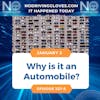Automobile, why do we use this term It Happened Today January 3, 1899 327s

Have you ever wondered where in the world the term “automobile” came from and when did it become popular in America??? While, you guessed it, It Happened Today… and a few other days, but we’re covering it today. Here is the story of a January 3rd, 1899 New York Times editorial and of Alexander Winton's wild ride from Cleveland to New York, the actual drive that put the "auto" in "automobile
#cars #car #collectorcars #oldcars #cartalk #electriccars #ev #hotrod #carhistory #automotivehistory #automobile #thisdayinautomotivehistory #thisdayinhistory #classiccars #onthisday #ithappenedtoday #january3 #winston #newyorktimes
Image and Background Audio from Pixabay
Everyone, gather 'round your radios, because It Happened Today has a tale for you today that'll have you revving up your history engines! Have you ever wondered where in the world the term “automobile” came from and when did it become popular in America??? While, you guessed it, It Happened Today… and a few other days, but we’re covering it today. Here is the story of a January 3rd, 1899 New York Times editorial and of Alexander Winton's wild ride from Cleveland to New York, the actual drive that put the "auto" in "automobile".
Now, imagine this: it's January 3rd, 1899, and the streets are still filled with horse-drawn carriages, top hats, and hoop skirts. You pick up a copy of the New York Times to read;
“There is something uncanny about these newfangled vehicles. They are all unutterably ugly and never a one of them has been provided with a good or even an endurable name. The French, who are usually orthodox in their etymology if in nothing else, have evolved "automobile," which being half Greek and half Latin is so near to indecent that we print it with hesitation; while speakers of English have been fatally attracted by the irrelevant word “horseless”.”
Little did anyone know that a mere 4 ½ months later, the New York Times and numerous other publications would fine tune their own etymology to accept this new word. On May 22, 1899 Alexander Winton, the man with a vision – or maybe he just had a bet with his buddy that he could make it to New York faster than the Pony Express, who really knows – left Cleveland, Ohio for New York in one of his famed Winton vehicles. Along for the ride, Charles B. Shanks of the Plain Dealer newspaper.
So, Winton decides to take his "horseless carriage," as they called it back then, for a little spin. I mean, who needs gas stations when you can just feed your car oats and carrots, right?
Picture this – a large carriage like wooden body on large rubber tires with a single-cylinder engine thumping along. It's not exactly the sleek, sexy cars we have today. But hey, it had four wheels and an engine, so it was practically a speeding locomotive off its tracks!
I like to imagine that Winton had a bit of a lead foot, zipping along those dirt roads like a man possessed, leaving horse-drawn carriages in the dust.
Imagine what bystanders reactions were! "Is that a runaway carriage without its horse or did someone spike the sarsaparilla?"
When word got around that Winton was planning to drive from Cleveland to New York City, a distance that's roughly the equivalent of traveling to the moon and back in those days. People were flabbergasted! They couldn't fathom the audacity of this man and his "devil wagon."
So, Winton is on the road, and you can imagine the obstacles he faced. No GPS, no service stations, and probably not a single drive-thru for miles. I bet he had to stop at a general store and ask for directions like, "Excuse me, good sir, can you point me to the nearest gasoline emporium?"
Now, here's the kicker – Winton makes it to New York in a blazing 47 hours and 34 minutes!
The newspapers of the time were all over it. Charles Shanks of the Plain Dealer, who was Winton’s co-pilot, had been wiring the story out along the entire journey. He and Winton had agreed to use the term “automobile” for the vehicle, versus the common term “horseless carriage”, and so “automobile” saw wide publication across the US.
And there you have it, folks – the tale of the New York Times and Alexander Winton's road trip that both helped etch the term "automobile" into our daily vocabulary!
Thanks for tuning in, folks! Until next time, keep laughing and keep those engines running – preferably with a bit more horsepower then Winton had! Remember, if you’re enjoying It Happened Today, give No Driving Gloves a like, share us with a friend, and subscribe to the podcast. As always… enjoy the ride!




